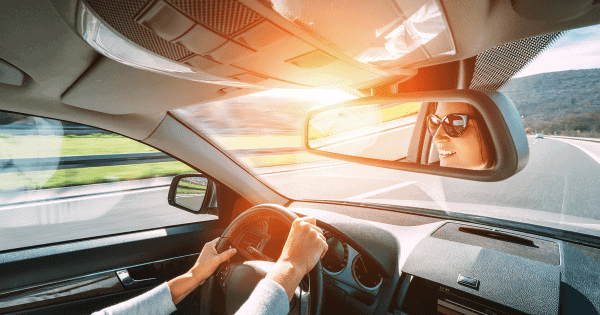- Need Any Help: +1 647-760-5505 or
- info@trubicars.ca

As you gain experience with your driving skills, it’s only natural to sometimes slip into bad habits and make minor mistakes. As an experienced driver, it is still natural to slip back into old bad habits that you thought you once corrected and still make minor mistakes. Sometimes, some drivers don’t even realize the bad habits and minor mistakes they are making behind the wheel until it is too late and there has been a collision. However, no matter how minor the bad habits may be and no matter how minor the mistakes you make are, you should always be diligent in correcting those habits and mistakes to ensure you are being safe and responsible behind the wheel. It’s never a good experience to be involved in a collision let alone be the cause behind a collision. At Trubicars, we ensure to emphasize to driving students how important it is to ensure that you are safe and responsible when operating a motorized vehicle. Trubicars has created this blog outlining 5 Common Mistakes Drivers Make and How to Avoid Them.

There are many forms of aggressive driving that you should ensure you are not engaging in while behind the wheel. One common form of aggressive driving is Tailgating (or following too closely). In ideal driving conditions, to avoid tailgating, use the 3-second rule! Leave at least 3 seconds between you and the car in front of you. In poor driving conditions, you should be increasing that distance. Speeding is also another common form of aggressive driving. It’s imperative that you take note of the speed limit on the road and maintain the posted speed limits, as they are there for a reason; to ensure drivers are driving at a safe speed. If you are driving at a high speed, you may find yourself unable to control your vehicle during an emergency and you may not be able to prevent a collision from happening and even worse, you may potentially turn any collision into a fatal one. If you are convicted of speeding, you may receive demerit points as well as a fine. The fine for driving over the speed limit will depend on how fast you were traveling over the speed limit. You can avoid speeding by giving yourself time to arrive at your destination, paying attention to your speedometer, taking note of the posted speed limits on the roads you are driving on, and not letting other road users (or passengers for that matter!) influence your driving and taking into consideration how damaging a speeding ticket may be to your driving record (i.e., increased insurance rates). By ensuring you follow the speed limit and also give yourself enough time to reach your destination, you can avoid this type of aggressive driving.

Wearing a seat belt is the most effective way to reduce injuries and save lives in traffic collisions. Minor collisions can become life-threatening and fatal if you or your passengers neglect to buckle-up. As a driver, not only are you legally required to wear a seatbelt, but you also must ensure every passenger under the age of 16 in the car with you has and wears a functioning seatbelt. Furthermore, you are responsible for ensuring that…
If you fail to wear a seatbelt, you can be fined between $200 and $1000 and risk losing 2 Demerit Points.

It’s imperative that while you are driving, you are paying attention to the road signs that you may encounter and adhering to the rules of the road. Be sure that your attention stays on the road so that you can minimize the risk of collisions. Always be paying extra attention when you are proceeding through an intersection, whether it be controlled with traffic lights or uncontrolled. Some road signs you may encounter are speed limit postings, stop signs, yield signs, school zone signs, etc. These road signs and rules are put in place for a reason; to ensure all drivers are driving safe!

Driving impaired is a serious offense on ALL roads. As a driver, you have a responsibility to remain sober behind the wheel. Impaired driving is not just driving drunk, contrary to popular belief, consuming cannabis is also impaired driving. When you drink, your reaction time is slower and your ability to make decisions is greatly affected. Alcohol can affect your attention span and you may experience blurred or double vision. Consuming cannabis before driving can affect your driving similar to how driving drunk affects you. Consuming cannabis before driving affects your judgment, and coordination and also slows your reaction time. The effects of Cannabis depend on THC levels, and how you have consumed it. You can feel the effects of Cannabis for as long as 6 hours. You can avoid driving under the influence by assigning a designated driver, using public transport, calling a trusted friend or family member for a ride, using a ride share or taxi service or staying overnight at your location.
Distracted Driving involves any activity that takes your focus away from driving. You are a distracted driver if you do any of the following behind the wheel:
These activities are technically not against the law; however, you can still be charged with careless driving, dangerous driving, or distracted driving. Distracted driving is a serious offense and has serious consequences, not only could you potentially injure yourself, but you can also injure other road users and pedestrians. Typically, most cases of distracted driving involve the use of a mobile phone, many drivers believe it is ok to send a text message or use your phone while you are stopped at a red light however this is ILLEGAL! The only time you can use your phone when you are in your car is when the vehicle is safely parked and turned off. There are many proactive steps you can take to ensure you are not driving distracted. You can always turn your phone off or switch it to silent, you can ask a passenger to respond to any messages, you can preselect and queue up your music before driving and if all else fails, you can always safely pull over to the side of the road to respond to any emergent notifications.
At Trubicars, we believe and emphasize the importance of how it is your duty as an operator of a motorized vehicle to ensure that you remain safe and responsible behind the wheel, not just for your sake, but for the sake of other road users. You should always be diligent in correcting bad driving habits and driving mistakes to ensure you are being safe and responsible behind the wheel. Give yourself some peace of mind and be sure to practice safe and responsible driving techniques. If you are looking for more information on 5 Common Mistakes Drivers Make and How to Avoid Them, check out the Trubicars website!

 January 3, 2025 by
January 3, 2025 by Trubicars
Trubicars
 February 13, 2024 by
February 13, 2024 by Reema Sharma
Reema Sharma
 January 17, 2024 by
January 17, 2024 by Trubicars
Trubicars
Once you acquire the knowledge provided in
those tests, you are ready to pass the test,
for the first time.
